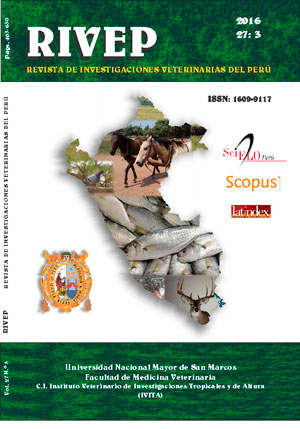Skull osteometry of the adult alpaca (Vicugna pacos)
DOI:
https://doi.org/10.15381/rivep.v27i3.11992Keywords:
alpaca, skull, osteometry, craniometric indexAbstract
This study aimed to evaluate the skull osteometry and to calculate the craniometric indexes of adult alpacas (Vicugna pacos). The study was carried out using 30 heads of adult Huacaya alpacas (15 males and 15 females), from the district of Sicuani, Cusco, Peru. The skulls were obtained by the maceration technique. The anatomical description was applied using the recommended terminology by the Veterinary Anatomical Nomenclature 2012. A digital vernier was used in the measurement and calculation of craniometric indexes. The «t» test was used to determine differences due to sex. The results showed that adult alpacas do not have sexual dimorphism related to craniometry values. The skulls are the dolichocephalic type with a Total Cephalic Index of 46.43% and ultradolichocranial with a Total Cephalic Index of 55.42%. The alpaca face is the hiperleptene type with a Facial Index of 103.17%, presents a Mandibular Index of 62.33% and the facial triangle is of scalene type.Downloads
Downloads
Published
Issue
Section
License
Copyright (c) 2016 Henry Castañeda C., Miluska Navarrete Z., Alberto Sato S., Alexander Chávez R.

This work is licensed under a Creative Commons Attribution-NonCommercial-ShareAlike 4.0 International License.
AUTHORS RETAIN THEIR RIGHTS:
a. Authors retain their trade mark rights and patent, and also on any process or procedure described in the article.
b. Authors retain their right to share, copy, distribute, perform and publicly communicate their article (eg, to place their article in an institutional repository or publish it in a book), with an acknowledgment of its initial publication in the Revista de Investigaciones Veterinarias del Perú (RIVEP).
c. Authors retain theirs right to make a subsequent publication of their work, to use the article or any part thereof (eg a compilation of his papers, lecture notes, thesis, or a book), always indicating the source of publication (the originator of the work, journal, volume, number and date).










